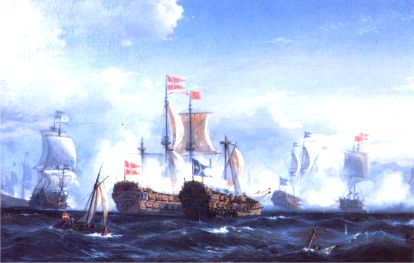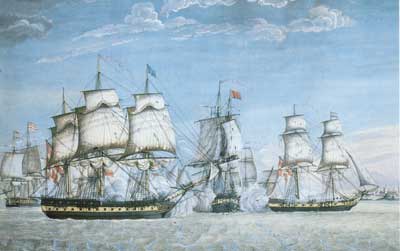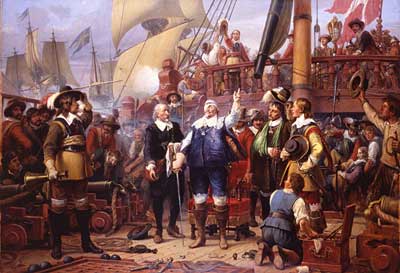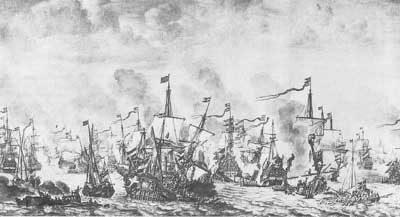|
You are here: 4Campaigns & Battles4Index4The Navy before 1801 |
|||||||||||||||||||||||||||||||||||||||||||||||||||
|
The Navy before 1801
The Birth of a Navy,
|
||||||||||||||||||||||||||||||||||||||||||||||||||
|
Niels Juel |
Niels Juel comes of age The dedication with which the navy was rebuilt began to pay off, and in 1676, Niels Juel succeeded in readying the navy by the end of March. A month later, he captured Gotland, which stayed in Danish hands during the entire war. In the latter part of May, the Swedish navy was spotted in the southern Baltic. Niels Juels was successful in keeping the superior Swedish fleet at bay until he was able to unite with the Dutch fleet commanded by General admiral Tromp, who entered the Baltic from the sound. The combined Danish-Dutch fleet was after that equal to the Swedish fleet. |
On June 1, 1676, the two fleets met in a violent battle off Oeland with the Danish-Dutch fleet drawing the longest straw. The Swedes suffered heavy losses and the victory gave control of the Baltic to the Danish-Dutch. This made possible a Danish invasion of Scania.
Once again, however, the army lacked the necessary luck in its land operations. After capturing the major part of Scania during the summer of 1676, the army lost the deciding battle near Lund and had to retreat to Landskrona.
At the beginning of 1677, the navy was once again equipped at an early date. In the May, it was at sea under the command of Niels Juel. The Swedes tried to unite the Gothenburg squadron with the main fleet to regain naval supremacy.
The Swedish Gothenburg squadron came down through the Great Belt right into the waiting arms of Niels Juel and his squadron. The Swedish squadron suffered a total defeat in the battle off Moen on June 1, 1677.
The Battle of Kّge Bay
The Swedes worked hard to ready their main fleet, and in June of 1677, a squadron of 36 ships sailed for the southern Baltic with orders to attack and destroy the Danish navy.
After the battle of Moen, Niels Juel had formed a line with his 24 ships between Stevns and Falsterbo. At the same time, he tried to keep himself informed of the Swedish navy’s maneuvers. On June 24, the Swedish ships cast anchor off Moen.
Six days later, the two fleets made contact, and the day after, July 1, 1677, the battle of Kّge Bay began. The Swedish fleet consisted of 18 men-of-war, 12 frigates, 6 fireships and 11 smaller ships. Niels Juels squadron was made up of 16 men-of-war, 9 frigates, 2 fireships and 7 smaller ships.
In total, the Swedes mustered 1.624 cannon and 9.200 men, while the Danish fleet "only" mustered 1.422 cannon and 6.700 men.

A dramatic
episode from Denmark’s most famous naval battle, the battle of Kّge
Bay, July 1, 1677. Admiral Niels Juel defeats a superior Swedish
force.
(Painting by Viggo Faurholt, from the naval museum’s archives)
Beginning at 5:30 a.m., the two fleets were engaged in violent battle. After nearly ten hours of intense fighting, the Swedish fleet was forced to withdraw after having lost eight men-of-war.
Before the battle, Niels Juel had received news the Dutch fleet was approaching from the north. They never made it to the battle, and with the solely Danish victory, Niels Juel won international fame.
The victory also meant the end of Danish dependence on the Dutch. The Danish navy had regained its confidence, which had suffered a severe blow from the Swede’s victory off Fehmern in 1644.
A brief peace and reorganization
In the last years of the Scanian war, the Danish navy had supremacy in the Danish-Norwegian territorial waters. However, mastery at sea was unable to compensate for the losses suffered by the army in Scania.
France dictated the conclusion of peace in Lund on October 7, 1679. It entailed an unchanged border between Denmark and Sweden and the return of all the captured land areas in Scania.
The peace treaty was a bitter pill to swallow after the many victories, particularly by the navy, during the three years of war. The war marked, however, a turning point for the building up of the navy.
Christian V introduced not only "Danske Lov" (Danish Law, 1683), but attempted various methods of reorganizing the navy and its structure.
The naval wharf at Bremerholm had become too small, and in 1680, it was decided to establish a wharf on Refshalen, east of the navy's until now base. This constituted the founding of Nyholm, and Holmen, the Royal Dockyard, which was later to become the navy's main base.
To support the navy in its operations in the Baltic, a base was also established on the Ertholm-islets. On October 4, 1684, the king gave the order to call the fort on the Ertholm-islets Christiansّ.
Since 1671, the navy had had a small base at Glückstadt, and a wharf at Frederikshald in Norway, which was expanded and moved to Christiansand in 1687. Naturally, shipbuilding continued.
The Swedish war that never happened
Once again, in the winter of 1682-1683 Denmark prepared itself for war with Sweden, and once again, the navy was equipped. Conflicts between the great powers and events beyond the realm’s borders lead yet again to sabre-rattling.
This time Sweden was allied with Holland, while Denmark formed an alliance with France, and both lands hoped for assistance from their allies' navies.
The French came first with a fleet that arrived in the Sound on June 26, 1683 and united with the Danish fleet. The French force was under the impression that war had already broken out. That was, however, not the case.
In August, the united Danish-French fleets weighed anchor and sailed into the Baltic and nothing happened. War never broke out, and in the beginning of October, the French fleet sailed for home.
The relationship between the Nordic countries improved – even though a provocative French foreign policy, repeatedly, came near to drawing Denmark into conflicts around Europe.
To war again
The threat of war with Sweden was minimized at the beginning of 1684, and Christian V ordered reductions in both the army and the navy. However, using the strength at his disposal right at the time, the king occupied the ducal enclaves in Slesvig, strongly provoked by the continuing intrigues of the Duke of Gottorp.
He had thereby once again united Slesvig with the Danish realm. The king's arbitrary line of action, however, did not sit well with the great powers of Europe, and in 1689, at Altona, Christian V was forced to make a compromise, which returned the captured areas.
This compromise would, only a few years later, in 1700, give Frederik IV problems and later yet create problems in Danish-German relations.
After the death of Niels Juels in 1697, command of the navy was given to the only nineteen year-old Ulrik Christian Gyldenlّve. The navy was still in good shape and, at the beginning of 1700; it was equipped to its full strength to once again be used against Sweden.
Yet again, events in Europe came to set their mark on Danish history. Frederik IV (1699-1730) had his army in Holsten, and had full confidence in the navy’s control of the sea.
The king had possibly not counted on Sweden’s new allies, Holland and England, arriving, each with their own fleet, to unite with the Swedish navy. During the summer, Karl XII succeeded in transferring an army to Sealand with the support of the large allied fleet.
Gyldenlّves squadron, which lay off Copenhagen, had no chance for intervention against the superior force. The situation resembled all too well the siege of Copenhagen in 1658. At the end of July, Copenhagen was subjected to a naval bombardment, which had no great effect.
Karl XII's invasion of Sealand gave Holland and England cold feet. They feared Swedish control of the Sound, and their fear resulted in what was practically a dictated peace.
The peace treaty meant for Denmark, that they were forced out of an alliance with Russia and Poland and had to accept the Duke of Gottorp's rights. The Swedish army was, escorted by the allies, transported back to Sweden.
For a short period peace reigned in Denmark-Norway. In the following years, only a small part of the navy was completely equipped. During the following decade, Denmark-Norway was like a uniquely peaceful enclave in a Europe that burned in the flames of war.
The Great Nordic War 1707-1720
Some years passed before Denmark once again found an opportunity to recapture the Scanian provinces.
Karl XII had been occupied at the beginning of the 1700s, in waging war against Russia and Poland. Denmark-Norway, in alliance with Russia and Poland used the opportunity to declare war on Sweden in 1707. The king gave the order to equip the navy.
´The Great Nordic War, the last war against Sweden had begun, and the navy’s task was again obvious.
As in earlier wars, the navy’s task was to keep the Swedish navy in check, protect supplies to Norway and at the same time prevent the Swedes from doing the same with their possessions along the Baltic coast.
With the navy’s support, an army of 16,000 men was landed at Raa slightly south of Helsingborg in 1709. Incidentally, the same location had been used in the invasion of 1676.
July 10, 1710 the two fleets met again in Kّge Bay, this time though, the battle ended with no clear victor.
The Danish-Norwegian fleet succeeded in making it back to Copenhagen without suffering any great losses. This was in no little way due to the heroic efforts of Captain Iver Huitfeldt on board the man-of-war DANNEBROGE.
Despite a violent fire on-board, he kept up the fight thus drawing the Swedish fleet’s attention away from the rest of the ships. After an hour's battle, the man-of-war exploded killing nearly 600 men – including Captain Iver Huitfeldt.
Health conditions on-board were not good in this year: In 1711, the navy's crews and the populations of both Copenhagen and Karlskrona were struck by the Plague, thus greatly reducing wartime activities.
Peter Wessel Tordenskiold (Thundershield)
|
When talk falls on the Great Nordic War, there is no avoiding the Danish-Norwegian navy's most colorful officer through the ages; Peter Jansen Wessel (1690-1720), from 1716 knighted under the name Tordenskiold (Thundershield). Peter Wessel, born in Trondheim, Norway was received as a cadet in the Danish-Norwegian Navy in 1709 and in a mere 11 years advanced to the rank of Vice admiral during the Great Nordic War. He was killed in a duel in Hildesheim in Germany. His untraditional and always quick-witted actions captured attention and commanded both national and international respect. The absolute zenith of his carrier was marked by the outstanding victories at Dynekilden, Gothen-borg and Marstrand, and they ensured Peter Wessel Tordenskiold a permanent place in Danish-Norwegian naval history. |
Contemporary
portrait of vice admiral |
Naval superiority
The Navy's success during the Great Nordic War was not alone because of Tordenskiold, but just as much due to the modernization that had taken place, and the navy's supreme commander General admiral Ulrik Christian Gyldenlّve (1678-1719).
In 1712, Gyldenlّve had succeeded in destroying and burning 80 Swedish transport ships, a daring operation, which effectively prevented the Swedes in relieving their forces at Stralsund.
After the shooting of Karl XII on December 11, 1718 during the siege of the Frederiksstens fortress in Norway, England and Holland decided the following year, to withdraw from the war. After that it became solely a Danish–Norwegian, Swedish affair concerned with the recapturing of the lost provinces.
When peace was finally established, on July 3, 1720, through English-French mediation, it had to be concluded that not much had been gained at all – despite the fact that Denmark-Norway emerged as the victor.
Yet again the interests of the great powers interfered, and Denmark-Norway had to return the captured areas in Bohus-province including Marstrand. In return, Denmark-Norway received guarantees for the possession of Slesvig and Sweden had to give up their freedom from duty in the Sound and pay Denmark-Norway a compensation 600.000 rix-dollars.
The end of the Great Nordic War also meant the end of nearly 200 years Danish-Swedish rivalry for the control of the Baltic. A third naval power, Russia, with borders on the Baltic, now became a player.
A period of peace
Nearly 13 years of war had taken its toll on both the navy and the national treasury. That meant a long-term period of building-up and reorganizing. Through the nearly eighty-year period of peace, the navy was rarely equipped in its entirety.
Denmark-Norway followed the terms of the mutual aid treaty and this meant that a Danish-Norwegian squadron in 1726-1727 operated with an English squadron in the Baltic to keep the large and aggressive Russian navy in check.
Count Frederik Danneskiold-Samsّes appointment as Commander in chief of the navy in 1735 resulted in many innovations for the Danish-Norwegian navy. These included an expansion of Nyholm and construction of the naval artillery's buildings.
The years of peace meant the navy's area of operations was limited to maintaining guard-ships in the Sound and the Great Belt, training cruises with cadets, and test cruises with new ships. In addition, there were cruises to Iceland, Greenland and the overseas colonies.
St. Jan and St. Thomas had been acquired at the end of the 1600's, and in 1733 St. Croix was purchased from France. This presented the navy's officers with great opportunities for cruises to the colonies, both with naval vessels and, increasingly, Danish-Norwegian merchant ships.
Convoying
During the last half of the 1700's, the navy received a new task far from home: escorting Danish Merchant ships in the Mediterranean. A rise in piracy had made this protection necessary.
Piracy had practically been systematized by the North African Barbary states, giving the piracy an air of officiality. Tribute had to be paid to the princes in Algiers, Tunis and Morocco to secure safety for the Danish flag.
When the tributes occasionally grew too large, a Danish-Norwegian squadron was equipped to bring the situation back into perspective. A case in point was the attacking of the city of Algiers in 1770 by a Danish-Norwegian naval force consisting of four men-of-war, two frigates and four smaller ships.
Even greater success was had by Commander Steen Bille when he, with the frigate NAJADEN, the brig SARPEN and a smaller ship sailed to Tripoli in 1797 to secure the release of Danish prisoners. After a dramatic battle with the Corsair's ships, Bille was able to make a settlement and buy the freedom of the Danish prisoners.
In 1762, the long period of peace was ending, as Czar Peter III rose to the throne in Russia. Peter was a descendent of the Gottorp lineage and was therefore a sworn enemy of Denmark. The Czar sent immediately an army toward Holsten, and Denmark was forced to mobilize.
A naval force of 14 men-of-war and 8 frigates were equipped and sent to the Baltic. However, before they go into action, Czar Peter III was overthrown, and the crisis resolved for the time being.

The battle off
Tripoli, 1797.
To the left is
the frigate NAJADEN and to the far right, the brig SARPEN.
(Picture from The Naval Museum’s archive)
War clouds gather once again
Towards the end of the 1700's, Denmark-Norway was marked by unstable government during the reign of the deranged Christian VII (1766-1808): A situation that also affected the leadership of the navy. The conditions were first stabilized when Crown Prince Frederik assumed leadership of the country with A. P. Bernstorff.
Conflicts between England and France, and the observance of various alliance related obligations entailed equipping part of the navy a number of times. However, Denmark succeeded in staying out of any military operations.
In 1794, Denmark-Norway formed a union of neutrality with Sweden, and the increased trade with war-torn Europe brought prosperity to the country. However, after the English in 1798 were successful in defeating the French navy, they began to search neutral shipping.
England began also to show interest in the neutral countries shipping which, protected by convoys could ship goods to England's enemies. Their attitude towards Denmark-Norway became more critical.
In July 1800, a Danish convoy was stopped in the English Canal, and the frigate FREYA and six merchant ships were forced to strike their flags after a short battle with three English frigates.
The event resulted naturally in diplomatic complications between Denmark and England, but Denmark-Norway was forced to stop the convoy service.
War clouds were gathering over Denmark-Norway. The situation with England was soon to be resolved.
|
Sources: |
||
|
& |
Danmarks Flهde - fra bue og pil til missil, by Jّrgen Teisen, Bogans forlag, 1984 (ISBN 87-7466-027-6) |
|
|
& |
Den Danske Flهdes Historie 1533-1588 - Christian 3's flهde, af Jّrgen H. Barfod, Marinehistorisk Selskabs Skrift nr. 25 i samarbejde med Gyldendal, Copenhagen 1995 (ISBN 87-00-24526-7) |
|
|
& |
Den Danske Flهdes Historie 1588-1660 - Christian 4's flهde, af Niels M. Probst, Marinehistorisk Selskabs Skrift nr. 26 i samarbejde med Gyldendal, Copenhagen 1996 (ISBN 87-00-28586-2) |
|
|
& |
Den Danske Flهdes Historie 1660-1720 - Niels Juels flهde, af Jّrgen H. Barfod, Marinehistorisk Selskabs Skrift nr. 27 i samarbejde med Gyldendal, Copenhagen 1997 (ISBN 87-00-30226-0) |
|
|
& |
Flهden gennem 450 هr, edited by Commander s.g. R. Steen Steensen, Martins Forlag, 2. edition, Copenhagen, 1970 (ISBN87-566-0009-7) |
|
|
& |
Flهdens fّdsel, af Jّrgen H. Barfod, Marinehistorisk Selskabs Skrift nr. 22, Copenhagen 1990 (ISBN 87-87720-08-6) |
|
|
& |
Orlogsmuseet - Introduktion til Flهdens historie, af Ole Lisberg Jensen, Orlogsmuseet, Copenhagen 1994 (ISBN 87-89322-14-2) |
|
|
44You are also referred to the Naval Bibliography |
||
![]()
- Do you miss a major event on this Site,
or do you hold a great story?
Are you able to contribute to the unfolding of
the Danish Naval History,
please
e-mail
me, enclosures are welcome.
Please remember to list your sources.
You can also use the Naval Web Forum on this web-site.
![]()
|
THE TOPIC STORIES: |
|
- Wars against England (1801-1814) - Reconstructing the Navy (1814-1848) - The 1st Schleswig War (1848-50) - The interim War Years (1850-64) - The 2nd Schleswig War (1864) - The long Period of Peace (1864-1914) - The Navy during the 1st World War (1914-1918) - The Interim Years (1919-1939) - The Navy during the 2nd World War (1939-1945) - The Cold War Period (1945-1989) - |
-






